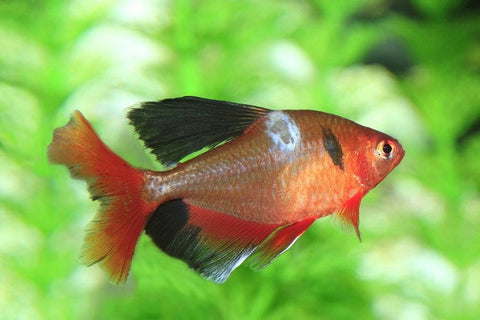Fish fungus is one of the most vulnerable diseases and your fish can die if left untreated. Fish are more vulnerable to fungal infection as they are living in an aquatic environment and hence the susceptible hosts for the fungi. Infection with fish fungus is often secondary to an underlying bacterial infection as well.
Fungus or infections caused by fungus are common among fish and aquariums. They may cause serious health problems, even death.
Knowing the symptoms and treatments are important for preventing and treating fungus infections.
In this article, we are going to discuss some common fish fungus and their symptoms, prevention, and treatment. Before, we will let you know about the fish fungus.
What is fish fungus?
Fish fungus is a type of infection that affects the skin, nails and hair. The fungus invades the fish and sometimes causes gill damage.
Fish fungus is an opportunistic infection of the skin and gills of fish. Fish fungus is caused by of genus Saprolegnia and related genera.
Saprolegnia species can be either free-living or parasitic and have a worldwide distribution. They reproduce through fission, or asexually.
What are the most common fish fungus?
There are various fish fungi spread by varieties of parasites in aquariums, but the most common among those are Saprolegniasis, Branchiomycosis, and Ichthyophonus.
Let's discuss these fish fungus causes, treatments, and prevention in detail.
1. Saprolegniasis
Saprolegniasis is a type of fungal infection that can affect both fish and amphibians. This fungus is usually found in freshwater fish and fish eggs.
Saprolegnia fungi normally live on the skin of fish and amphibians and cause no or very little harm. They can encounter wounds or damaged skin of the host, and start to grow rapidly, consuming the tissue.
If a fish or amphibian has Saprolegniasis, it can suffer from extreme loss of tissue, wounds that will not heal, and eventually death.

Symptoms
Saprolegnia is a genus of fungi often found in fish tanks. Saprolegnia usually appears as white spots on the gill of a fish and looks like cotton or cotton socks. It is a parasite that infects the skin, gills, and fins of fish, causing them to look as though they are rotting.
Although not often fatal, it can make prized catches seem less valuable. Affected fish becomes sluggish, stops eating and loses color. In advanced cases, they die in a few days.
Causes
The cause of the disease is a fungus from the genus Saprolegnia. It lives in water and attaches to the fish or eggs. In warm and dirty water, it multiplies rapidly. The fungus usually develops on organic matter, and it needs air to breathe. Mostly, the disease is spread through dirty water conditions and decaying organic matter.
Treatment & Prevention
- Treat water with a regular saltwater bath with Potassium Permanganate.
- Frequent water change and sanitizing of the tank.
- Keep your fish diet healthy
- Raise your tank temperature to somewhat around above 80℉.
2. Branchiomycosis
Branchiomycosis is a fungal infection of the gills (branchial) and the tissues that surround fish. It is also known as gill fungus or branchiomycosis.
The disease is also called "ear fungus," and this name is sometimes applied to other types of fungal infections that infect other parts of the fins.
If caught early, it may be treated with a course of anti-fungal medications. However, left to develop, it can cause death. Familiarity with this disease is important because it can be a major problem during or following outbreaks of disease in aquarium fish or when fish are relocated to different water bodies.

Symptoms
The infection usually first appears as white spots on the gill filaments of fish. These white spots grow and coalesce into larger lesions, which then turn brownish. The disease causes severe damage to the gills, resulting in difficulties in respiration and often death.
Causes
This disease is caused by several types of fungal organisms, most commonly by the genera Branchiomyces, Fusarium, Phaeoacremonium, Phellinus and Scedosporium.
It is believed that the current situation is Branchiomycosis - an increase in the incidence due to higher water temperatures, which led to favorable conditions for their development and spread.
Treatment & Prevention
There is no specific diagnosis for this fungus but some of the following preventive measures can be beneficial in reducing the effects.
- Be sure that you wash all utensils with hot water before use.
- Before adding new water, make sure it is boiled for 10 minutes to eliminate all bacteria that can cause various diseases.
- Make sure you buy only healthy fish from a reputable dealer, who will breed them in a healthy environment. Fish should only be added to a healthy aquarium with correct water parameters and good air quality.
- Avoid breeding at a higher temperature.
3. Ichthyophonus
Ichthyophonus is a common fungus that is found on the skin of catfish, trout, and salmon. It is a different fungus from Saprolegnia which affects fish in the same ways but does not have an exoskeleton.
It is commonly found on the skin of fish when the fish are transported from one location to another in warm water which provides an ideal breeding ground for the fungus.
The virus usually doesn't do any harm to the fish and is only noticed when the fungus itself begins to appear. However, fish with Ichthyophonus usually suffer from higher mortality rates than those that do not have the fungus.
Though it does not harm the fish itself, it does affect the quality of meat or fish and can cause chemical changes in the meat.
Symptoms
It can be identified by its fuzzy orange spores that are often on the fish's gills and mouth. Humans who handle infected fish may get some of these spores on their hands and they may contract it by touching their mouth or eyes soon after.
Infected fish have been known to have pale white patches on their skin and fins are often brittle. Infected fish have been known to have pale white patches on their skin and fins are often brittle.
Cause
It is caused by a fungus, Ichthyophonus. It is a disease of the fish skin and gills and occurs in all freshwater fish but especially in goldfish and carp. Because it does not require a free oxygen environment to survive, it can occur in almost any organ or tissue of the infected host.
It can be contracted both by fish and humans alike through contact with infected fish or if they come into contact with the spores that are released by Ichthyophonus.
Treatment and Prevention
- The fish that have this fungus are more susceptible to stress and disease, which is why it's best to keep them in optimal conditions.
- Quick and easy treatment of Ichthyophonus is salt in a solution of 1 tablespoon per 4L water (1 teaspoon per gallon) for at least 2 hours. The best results are achieved when the temperature does not exceed 77℉. Salt treatment will not be effective if the above conditions are not met.
- Avoid an oxygenated cool environment in the tank.
Conclusion
By the end of the above article, we come to know about the most common fungus found in fish. Fish Fungus is the most dangerous disease separated through parasites and timely prevention can reduce the risk of fish death. That’s why we have provided you with detailed information about the three most common fungus outbreaks, their symptoms, and their cause.
Moreover, we have provided you with some treatment details as well that you can do at your home after consultation with the veteran pet. By taking the above preventive measures, most beginner aquarists can save their aquariums from a certain fungal disease.


Comments (0)
Back to Fish Care